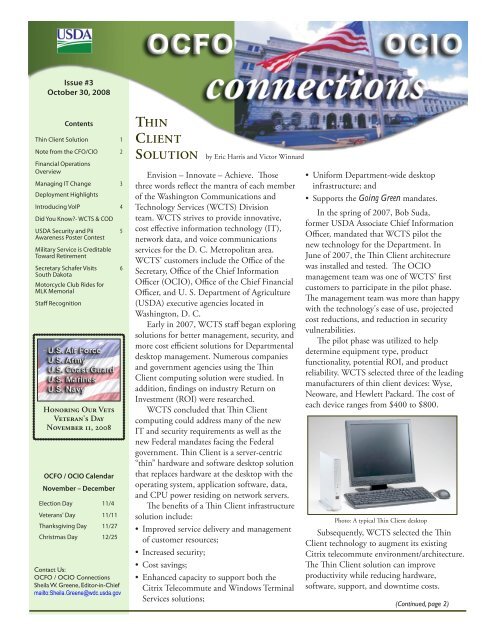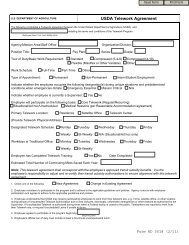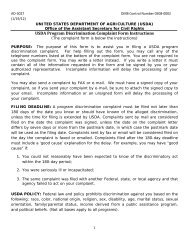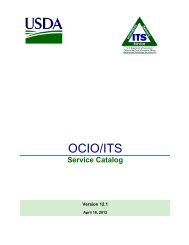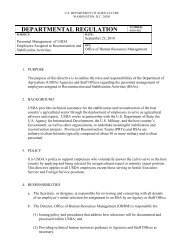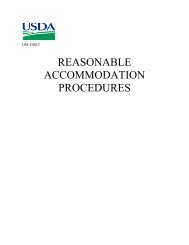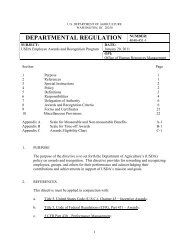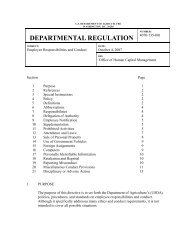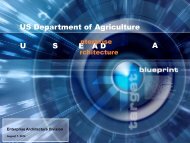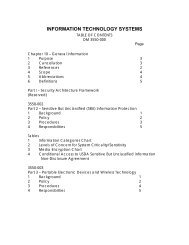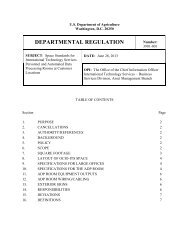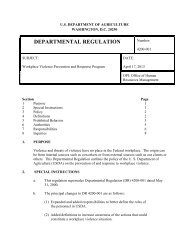thin client solution - OCIO Home Page - US Department of Agriculture
thin client solution - OCIO Home Page - US Department of Agriculture
thin client solution - OCIO Home Page - US Department of Agriculture
Create successful ePaper yourself
Turn your PDF publications into a flip-book with our unique Google optimized e-Paper software.
Issue #3<br />
October 30, 2008<br />
Contents<br />
Thin Client Solution 1<br />
Note from the CFO/CIO 2<br />
Financial Operations<br />
Overview<br />
Managing IT Change 3<br />
Deployment Highlights<br />
Introducing VoIP 4<br />
Did You Know?- WCTS & COD<br />
<strong>US</strong>DA Security and Pii 5<br />
Awareness Poster Contest<br />
Military Service is Creditable<br />
Toward Retirement<br />
Secretary Schafer Visits<br />
South Dakota<br />
Motorcycle Club Rides for<br />
MLK Memorial<br />
Staff Recognition<br />
Honoring Our Vets<br />
Veteran's Day<br />
November 11, 2008<br />
OCFO / <strong>OCIO</strong> Calendar<br />
November – December<br />
Election Day 11/4<br />
Veterans' Day 11/11<br />
Thanksgiving Day 11/27<br />
Christmas Day 12/25<br />
Contact Us:<br />
OCFO / <strong>OCIO</strong> Connections<br />
Sheila W. Greene, Editor-in-Chief<br />
mailto:Sheila.Greene@wdc.usda.gov<br />
6<br />
THIN<br />
CLIENT<br />
SOLUTION<br />
by Eric Harris and Victor Winnard<br />
Envision – Innovate – Achieve. Those<br />
three words reflect the mantra <strong>of</strong> each member<br />
<strong>of</strong> the Washington Communications and<br />
Technology Services (WCTS) Division<br />
team. WCTS strives to provide innovative,<br />
cost effective information technology (IT),<br />
network data, and voice communications<br />
services for the D. C. Metropolitan area.<br />
WCTS’ customers include the Office <strong>of</strong> the<br />
Secretary, Office <strong>of</strong> the Chief Information<br />
Officer (<strong>OCIO</strong>), Office <strong>of</strong> the Chief Financial<br />
Officer, and U. S. <strong>Department</strong> <strong>of</strong> <strong>Agriculture</strong><br />
(<strong>US</strong>DA) executive agencies located in<br />
Washington, D. C.<br />
Early in 2007, WCTS staff began exploring<br />
<strong>solution</strong>s for better management, security, and<br />
more cost efficient <strong>solution</strong>s for <strong>Department</strong>al<br />
desktop management. Numerous companies<br />
and government agencies using the Thin<br />
Client computing <strong>solution</strong> were studied. In<br />
addition, findings on industry Return on<br />
Investment (ROI) were researched.<br />
WCTS concluded that Thin Client<br />
computing could address many <strong>of</strong> the new<br />
IT and security requirements as well as the<br />
new Federal mandates facing the Federal<br />
government. Thin Client is a server-centric<br />
“<strong>thin</strong>” hardware and s<strong>of</strong>tware desktop <strong>solution</strong><br />
that replaces hardware at the desktop with the<br />
operating system, application s<strong>of</strong>tware, data,<br />
and CPU power residing on network servers.<br />
The benefits <strong>of</strong> a Thin Client infrastructure<br />
<strong>solution</strong> include:<br />
• Improved service delivery and management<br />
<strong>of</strong> customer resources;<br />
• Increased security;<br />
• Cost savings;<br />
• Enhanced capacity to support both the<br />
Citrix Telecommute and Windows Terminal<br />
Services <strong>solution</strong>s;<br />
• Uniform <strong>Department</strong>-wide desktop<br />
infrastructure; and<br />
• Supports the Going Green mandates.<br />
In the spring <strong>of</strong> 2007, Bob Suda,<br />
former <strong>US</strong>DA Associate Chief Information<br />
Officer, mandated that WCTS pilot the<br />
new technology for the <strong>Department</strong>. In<br />
June <strong>of</strong> 2007, the Thin Client architecture<br />
was installed and tested. The <strong>OCIO</strong><br />
management team was one <strong>of</strong> WCTS’ first<br />
customers to participate in the pilot phase.<br />
The management team was more than happy<br />
with the technology's ease <strong>of</strong> use, projected<br />
cost reductions, and reduction in security<br />
vulnerabilities.<br />
The pilot phase was utilized to help<br />
determine equipment type, product<br />
functionality, potential ROI, and product<br />
reliability. WCTS selected three <strong>of</strong> the leading<br />
manufacturers <strong>of</strong> <strong>thin</strong> <strong>client</strong> devices: Wyse,<br />
Neoware, and Hewlett Packard. The cost <strong>of</strong><br />
each device ranges from $400 to $800.<br />
Photo: A typical Thin Client desktop<br />
Subsequently, WCTS selected the Thin<br />
Client technology to augment its existing<br />
Citrix telecommute environment/architecture.<br />
The Thin Client <strong>solution</strong> can improve<br />
productivity while reducing hardware,<br />
s<strong>of</strong>tware, support, and downtime costs.<br />
(Continued, page 2)
(Continued from page 1)<br />
Thin Client provides a secure, productive desktop and<br />
remote computing environment by centralizing data<br />
storage on the network. This dramatically reduces desktop<br />
data security vulnerabilities.<br />
WCTS selected Accelera Technologies to assist in the<br />
installation and upgrade <strong>of</strong> the architectural backbone in<br />
January 2008. The server installation is complete and will<br />
support approximately 1,000 users. WCTS designed this <strong>solution</strong><br />
to be upwardly expanded to support more than 10,000<br />
users <strong>Department</strong>-wide and can scale this design to grow as<br />
the needs and requirements <strong>of</strong> the <strong>Department</strong> change.<br />
WCTS will deploy the Thin Client <strong>solution</strong> to three<br />
categories <strong>of</strong> users: 1) regular users, 2) power users, and<br />
3) high end users. WCTS will work with agency<br />
A Note from CFO/CIO Charles R. Christopherson, Jr.<br />
As we start a new fiscal year, I look forward to the progress our OCFO and <strong>OCIO</strong> teams will<br />
continue to make in the upcoming year. Privacy, cyber security, and implementation <strong>of</strong> the<br />
Financial Management Modernization Initiative (FMMI), as well as many other projects, will be<br />
an important part <strong>of</strong> 2009. We will continue to see progress in the movement to four<br />
enterprise data centers and the usage <strong>of</strong> Voice and Video over Internet Protocol. Continued<br />
progress on these <strong>thin</strong>gs will allow both OCFO and <strong>OCIO</strong> to continue to reduce spending,<br />
which will be crucial in order to make progress in other areas. There are many projects and<br />
goals that the leadership <strong>of</strong> both organizations has set for our teams. I know that each <strong>of</strong> you<br />
will continue your hard work to ensure that we succeed.<br />
Ho w oCFo a n d oCIo Co n n e C t to Su p p o r t uSda InItIatIveS<br />
As part <strong>of</strong> the U. S. <strong>Department</strong> <strong>of</strong> <strong>Agriculture</strong>’s (<strong>US</strong>DA)<br />
Office <strong>of</strong> the Chief Financial Officer (OCFO), the Associate<br />
Chief Financial Officer for Financial Operations (ACFO-FO)<br />
provides oversight <strong>of</strong> <strong>US</strong>DA agencies’ financial functions by<br />
establishing financial policy and administering the appropriate<br />
controls to ensure compliance. John Brewer, ACFO-FO,<br />
directs the three divisions under the ACFO-FO umbrella:<br />
Accounting Policy and Consolidated Reporting Division<br />
(APCRD), Controller Operations Division (COD), and<br />
Systems Analysis and Requirements Division (SARD).<br />
ACFO-FO is responsible for <strong>Department</strong>-wide financial<br />
operations and reporting which includes assets <strong>of</strong><br />
$140 billion and operating costs <strong>of</strong> $90 billion for 7 mission<br />
areas, 18 agencies, 3 corporations, and 11 staff <strong>of</strong>fices.<br />
APCRD, under the direction <strong>of</strong> Kevin Close, performs<br />
financial reporting functions that include the preparation <strong>of</strong><br />
the <strong>Department</strong>'s consolidated financial statements, as well as<br />
acting in an advisory role to financial management personnel<br />
throughout the <strong>Department</strong>.<br />
COD, under the direction <strong>of</strong> Charles Wallace, is<br />
responsible for the operational financial functions. In<br />
Financial Operations Overview<br />
By Susan Showalter<br />
<strong>Page</strong> 2<br />
representatives to decide which users are good candidates for<br />
the Thin Client <strong>solution</strong>.<br />
WCTS has successfully deployed Thin Client devices to<br />
the Continuity <strong>of</strong> Operations (COOP) Level 4 location and<br />
the <strong>OCIO</strong> COOP location in Beltsville, Maryland.<br />
In addition, the Thin Client devices have been successfully<br />
deployed by WCTS in agencies wi<strong>thin</strong> the <strong>Department</strong>.<br />
WCTS will provide a full range <strong>of</strong> services to support all<br />
aspects <strong>of</strong> Thin Client implementation and operation. Valarie<br />
Burks, WCTS Director, states, “WCTS is very excited about<br />
the possibilities and improved efficiencies that Thin Client<br />
will bring to <strong>US</strong>DA. It is definitely a technology that, when<br />
properly utilized, will help <strong>US</strong>DA to operate more efficiently<br />
and securely.”<br />
addition to financial reporting, COD services to customer<br />
agencies wi<strong>thin</strong> <strong>US</strong>DA include administrative payments<br />
processing, certification <strong>of</strong> payments, cash and property<br />
reconciliation, Intra-governmental Payment and Collection<br />
(IPAC), vendor table maintenance, related regulatory policy<br />
compliance, and support (i.e., training). Division activities<br />
involve many diverse tasks such as payment <strong>of</strong> agency utility<br />
bills and <strong>US</strong>DA’s timely and accurate reporting to the U.S.<br />
<strong>Department</strong> <strong>of</strong> the Treasury.<br />
SARD, under the direction <strong>of</strong> Howard Campbell,<br />
provides operational financial guidance and assistance to<br />
financial management <strong>of</strong>ficials and personnel throughout<br />
<strong>US</strong>DA. SARD works closely with the Office <strong>of</strong> the<br />
Associate Chief Financial Officer for Financial Systems<br />
(ACFO-FS) regarding use <strong>of</strong> existing financial management<br />
tools and development <strong>of</strong> new financial management<br />
accounting systems such as the Financial Management<br />
Modernization Initiative (FMMI).<br />
The three ACFO-FO divisions work collaboratively to<br />
manage the finances <strong>of</strong> one <strong>of</strong> the largest departments in<br />
Federal government.
Information Technology (IT) change management is<br />
required to keep the Information Technology Services (ITS)<br />
large, complex computing environment updated and operational.<br />
Daily, the computers <strong>of</strong> more than 50,000 Farm<br />
Service Agency (FSA), Natural Resources Conservation<br />
Service (NRCS), and Rural Development (RD) employees<br />
(and their partners) automatically receive new s<strong>of</strong>tware, upgrades,<br />
and security features — the last stage <strong>of</strong> a methodical<br />
and carefully executed deployment process. The Infrastructure<br />
Deployment Branch, also known as the Interoperability Lab<br />
(IO Lab), conducts the deployment process and uses newsflashes<br />
to communicate with the support staff.<br />
Newsflashes provide a quick, efficient method <strong>of</strong> providing<br />
critical information to IT support staff. The ITS Newsflash<br />
has evolved over the years. At first, information was sent out<br />
to IT staff when mainframes were being serviced or down for<br />
an extended period <strong>of</strong> time. Information provided to IT staff<br />
allowed them to better plan their work and respond to end<br />
users when questions arose about why a service was unavailable<br />
or a remote program would not run.<br />
As the computing environment moved from mainframes<br />
to local workstation processing, the information in the<br />
newsflash notified the IT support staff <strong>of</strong> all actions and<br />
events that affected the end users. The ITS Newsflash is<br />
directed primarily to ITS-Technical Support Division (TSD)<br />
staff but is also received by other ITS operational and support<br />
Agency/Initiator and<br />
ITS Release Manager<br />
RD Initiator-<br />
Michael Dinneny<br />
TS/IDIB Release Manager<br />
David Hyde<br />
RD Initiator-<br />
Carol Townsend<br />
ITS/IDB Release Manager -<br />
Kristen Gallogly<br />
NRCS Initiator-<br />
Ken Rojas<br />
ITS/IDB Release Manager-<br />
Kathy Bashaw<br />
NRCS/Initiator -<br />
Greg Hadish<br />
ITS/IDB Release Manager-<br />
Kathy Bashaw<br />
Managing IT Change by Sheila Greene and Steve Spector<br />
Deployment Highlights - July/August 2008<br />
<strong>Page</strong> 3<br />
organizations that need to be notified. The information in the<br />
Newsflash helps the TSD staff plan for upcoming application<br />
releases, project deadlines, and information about broken<br />
processes and applications. As originally intended, it informs<br />
the IT staff <strong>of</strong> critical information so they can respond to end<br />
users when questions arise.<br />
The ITS Newsflash itself has evolved into a document<br />
library where each Newsflash (beginning in June 2006) is<br />
created for a specific project or announcement. Each<br />
Newsflash is named with a date and category format so it can<br />
easily be retrieved from an archived database and the needed<br />
information referenced. ITS Newsflashes are sent to all ITS-<br />
TSD staff using an email distribution group. A Portable<br />
Document Format (PDF) version <strong>of</strong> the newsflash is attached<br />
for easy, <strong>of</strong>f-line reference and the content <strong>of</strong> the Newsflash is<br />
also readable in the email itself. Archives <strong>of</strong> the Newsflashes<br />
are stored on the IT Resources Web site and can be sorted and<br />
reviewed by category, subject, title, platform, operating system<br />
and date.<br />
Each IT change is evaluated, tested, and deployed in a<br />
way that assures the computing system will remain secure and<br />
stable. Detailed information about the IO Lab and managing<br />
IT change is featured in ITS Connections Issue 5 and Issue 6.<br />
The Deployment Highlights below were selected from 239<br />
projects completed during July and August 2008. Bottom<br />
photos: Courtesy <strong>of</strong> ITS, NRCS, and <strong>US</strong>DA Photo Library.<br />
Project Name Deployment Description<br />
DB2 PE 8.1 (Personal Edition) Fix Pack (FP) 16 is an application<br />
used by Rural Development for database applications on<br />
individual workstations.<br />
Guaranteed Loan System (GLS) Word Plugin is an application<br />
used by Rural Development to import Word documents into<br />
the RD Image Repository directly from wi<strong>thin</strong> MS Word. The<br />
image repository stores images <strong>of</strong> various documents for GLS<br />
and other RD systems. This saves users from having to print<br />
the documents and scan them into the RD Image Repository.<br />
Waterway Design Tool is an application for NRCS used by<br />
States actively involved in grass lined waterway design as<br />
a conservation practice at the state, county, and field <strong>of</strong>fice<br />
level.<br />
NRCS Data Tools for ArcMap 9.2 is an application designed by<br />
and for NRCS in Iowa to provide field <strong>of</strong>fice ArcMap users with<br />
simplified methods for accessing geodata and editing.<br />
Fix Pack 16 for this application was deployed to all Kansas City<br />
Large Office users <strong>of</strong> the IBM DB2 Personal Edition S<strong>of</strong>tware<br />
to resolve several critical security vulnerabilities as described<br />
in the June 2008 desktop vulnerability report issued by the<br />
Security Office.<br />
This upgrade has been accomplished via Systems<br />
Management Server (SMS) deployment to 50 <strong>client</strong><br />
workstations located in the St. Louis <strong>of</strong>fices.<br />
This application was distributed through the Engineering<br />
Field Tools Framework (EFT) and was installed via remote<br />
installation from the National Engineering Field Tools Update<br />
Center (http://www.eft.nrcs.usda.gov).<br />
This application was deployed through the IT Resources<br />
Web site. The application is specific to Iowa NRCS.
Traditional telephone networks devote an entire phone<br />
line to the transmission <strong>of</strong> a conversation. With Voice over<br />
Internet Protocol (VoIP), conversations are digitized, compressed,<br />
and transmitted over a network that also carries<br />
data. As a result, VoIP uses substantially less bandwidth than<br />
a traditional telephone call and can consequently be more<br />
cost effective. Because VoIP voice packets are transmitted in<br />
a fashion similar to other data, users can attach documents<br />
to voice messages. In addition, call waiting, call forwarding,<br />
call blocking, and caller identification (caller ID) are typically<br />
standard features <strong>of</strong> VoIP and can be easily activated by<br />
system administrators at no extra charge. VoIP handsets are<br />
usually small and lightweight enough to be easily moved from<br />
location to location wi<strong>thin</strong> the same VoIP network. Thus, it<br />
is important to note that migration to a VoIP network from a<br />
traditional telephone network requires replacement handsets<br />
as well as network components.<br />
In an effort to take advantage <strong>of</strong> the benefits <strong>of</strong> VoIP, six <strong>of</strong><br />
<strong>US</strong>DA’s largest agencies have already implemented independent<br />
VoIP networks based on different technologies. While<br />
this approach supports individual agency missions, it leads to<br />
redundant resources and can result in a lack <strong>of</strong> interoper-<br />
ability between networks across the enterprise.<br />
More than a year ago, <strong>US</strong>DA agencies and staff <strong>of</strong>fices<br />
launched Phase I <strong>of</strong> an enterprise-wide VoIP initiative to<br />
ensure that next-generation VoIP projects meet common<br />
standards, eliminate redundancies, and optimize end-to-end<br />
performance. The VoIP working group comprised nearly<br />
forty agency representatives and two contractors — one to<br />
document requirements, perform baseline research and deliver<br />
findings; the other, to develop baseline standards.<br />
Working group members discovered that VoIP standards<br />
are generally still immature, and though many <strong>of</strong> them are<br />
adopted by national and international standards organizations,<br />
vendors' implementations <strong>of</strong> such standards still vary.<br />
Moving forward, working group members agreed that<br />
Internet Protocol (IP) deployments should evolve toward<br />
common enterprise architecture with each new acquisition.<br />
They also determined that:<br />
• Enterprise IP architecture should promote flexible and<br />
forward-<strong>thin</strong>king interoperable standards to avoid becoming<br />
a source <strong>of</strong> technology stagnation in the <strong>US</strong>DA.<br />
• The enterprise network backbone will require technology<br />
upgrades to maintain current levels <strong>of</strong> availability and<br />
quality <strong>of</strong> service for both voice and data to support unified<br />
IP requirements.<br />
• Agencies must be willing to support Universal Telecommunications<br />
Network/UTN-to-the-desk connectivity to avoid<br />
unnecessary “hops” between legacy local area networks<br />
and the enterprise backbone. This will enable network<br />
Introducing VoIP<br />
by Susan Moore<br />
<strong>Page</strong> 4<br />
operations troubleshooting to the desktop and end-to-end<br />
security enhancements.<br />
<strong>US</strong>DA has now transitioned to Phase II which is managed<br />
by <strong>US</strong>DA’s Technical Review Board (TRB), a change control<br />
board established to maintain the integrity <strong>of</strong> the <strong>US</strong>DA enterprise<br />
network backbone. The TRB has formed an Integrated<br />
IP Standards Subcommittee and VoIP Working Group that<br />
will make recommendations for the definition, prioritization,<br />
and enterprise-wide adoption <strong>of</strong> integrated IP standards to the<br />
<strong>US</strong>DA Executive Change Control Board (ECCB). The ECCB<br />
will review the TRB recommendations and submit them for<br />
approval to the <strong>US</strong>DA Chief Information Officer. In addition,<br />
the subgroup plans to:<br />
• Review and comment on IP Acquisition Approval Requests;<br />
• Identify and recommend <strong>Department</strong>-wide standards for<br />
network IP services such as Voice and Video over IP;<br />
• Implement a strategy for migrating from stove-pipe legacy<br />
IP networks into a single, unified IP enterprise backbone;<br />
• Develop and implement a governance strategy and guidelines<br />
for managing IP technologies across the <strong>Department</strong>;<br />
• Manage processes for maintaining IP network configuration<br />
change control;<br />
• Establish processes for incorporating IP into the <strong>US</strong>DA<br />
Enterprise Architecture;<br />
• Promote enterprise–wide IP acquisitions; and<br />
• Make recommendations for <strong>US</strong>DA enterprise policy on IP<br />
technologies.<br />
Agencies that have an IP installed base and those interested<br />
in IP technology will have an opportunity to actively<br />
participate in the TRB Integrated IP Standards Subcommittee<br />
and VoIP Working Group. For more information contact<br />
Vernelle Archer, TRB Chairperson, at: 301-504-2040.<br />
Did You Know?<br />
In Fiscal Year 2008, Washington Communications and<br />
Technology Services processed more than 200 million<br />
messages, trapped more than 156 million spam messages,<br />
and answered more than 14,064 Employee Locator<br />
inquiries.<br />
Q<br />
Upon request, the Controller Operations Division,<br />
Customer Liaison and Training Branch conducts training<br />
sessions for <strong>US</strong>DA agencies in New Orleans, Washington,<br />
D.C., or an agency site on a fee-for-service basis.<br />
Continuing Pr<strong>of</strong>essional Education credits are awarded<br />
upon successful completion <strong>of</strong> the course. For more<br />
information, call (504) 426-5471, or email:<br />
customer.training@usda.gov
<strong>US</strong>DA Security and Pii Awareness Poster Contest<br />
by Evelyn Davis and Shang Lee<br />
Personally Identifiable Information, or Pii, refers<br />
to information that can be used to distinguish or<br />
trace an individual’s identity. Pii can include information<br />
or combinations <strong>of</strong> information such as social<br />
security numbers (in complete or truncated form),<br />
place <strong>of</strong> birth, date <strong>of</strong> birth, mother’s maiden name,<br />
biometric record, fingerprint, iris scan, DNA, medical<br />
history, medical conditions, financial information,<br />
credit card numbers, bank account numbers, etc.<br />
<strong>US</strong>DA must protect Pii for both employees and<br />
customers since Pii has a direct and critically<br />
important impact on everyone’s life. To heighten<br />
awareness and increase involvement <strong>of</strong> everyone who<br />
may be handling or in contact with Pii, the Office <strong>of</strong><br />
the Chief Information Officer (<strong>OCIO</strong>), Cyber Security,<br />
sponsored a <strong>US</strong>DA Security and Pii Awareness<br />
Poster Contest that began August 15 and ended<br />
September 15, 2008.<br />
The theme <strong>of</strong> the contest was “Protect It Like Your<br />
Own.” As part <strong>of</strong> the rules, contestants were required<br />
Military Service is Creditable Toward Retirement<br />
by Loyce Smith and Bruce Pacot<br />
Generally, all honorable active duty military service is<br />
potentially creditable under the Civil Service Retirement System<br />
(CSRS) and the Federal Employees Retirement System<br />
(FERS). Some military service is creditable automatically;<br />
but, other military service may require that you make a<br />
monetary deposit to your CSRS or FERS account.<br />
Options to buy back military time to count towards your<br />
civilian retirement are dependent upon your time <strong>of</strong> service<br />
and your civilian retirement system. Once you become<br />
employed with the Federal government, you have 2 years to<br />
complete the formal process or interest will be added to the<br />
calculated amount you owe (approximately 3 percent <strong>of</strong> total<br />
military earnings). Some employees have waited until retirement<br />
time and have retired without this additional benefit.<br />
You should not wait! Review the information immediately so<br />
you can obtain a benefit for serving your country.<br />
You must request a statement <strong>of</strong> your military earnings<br />
from your military finance center by completing an Office <strong>of</strong><br />
Personnel Management (OPM) Form RI 20-97, Estimated<br />
Earnings during Military Service, and send it to the appropriate<br />
military finance center. Your DD-214, Report <strong>of</strong> Transfer<br />
or Discharge, must be attached to the request. Once you<br />
receive the earnings statement, you must submit the returned<br />
<strong>Page</strong> 5<br />
to submit posters that focused on the security and Pii<br />
awareness theme and suggest preventive measures to<br />
protect information <strong>Department</strong>-wide. All works had<br />
to be original and became the property <strong>of</strong> <strong>US</strong>DA.<br />
Cyber Security will be authorized to use, reproduce,<br />
publish, and publicly display the posters and/or<br />
designs, in whole or in part, in any manner for any<br />
security awareness purpose.<br />
Employee participation has been excellent and<br />
judging will be difficult. The final count is 91 posters<br />
submitted by employees from Animal and Plant<br />
Health Inspection Service (APHIS), Agricultural<br />
Marketing Service (AMS), Agricultural Research<br />
Service (ARS), Forest Service (FS), Farm Service<br />
Agency (FSA), Food Safety and Inspection<br />
Service (FSIS), National Agricultural Statistics Service<br />
(NASS), Natural Resources Conservation Services<br />
(NRCS), <strong>OCIO</strong>, and Rural Development (RD). The<br />
creativity and variations on the theme shown on the<br />
posters received have been impressive.<br />
form to Human Resources (HR) for verification and final<br />
calculations that will be sent to the National Finance Center<br />
for processing. HR will notify you when this action is completed<br />
so you can select the payment plan that is appropriate<br />
for you to finalize this process. Once you select the appropriate<br />
payment plan, the compounded interest fee will stop. It is<br />
important to pursue the options NOW! It is imperative that<br />
you complete the deposit before OPM finalizes your retirement<br />
application. There are several articles in the Government<br />
Executive publication (www.govexec.com) that refer to this<br />
topic. Other regulations that apply to receiving this benefit<br />
can be found at the following Web sites:<br />
FERS Retirement Information<br />
http://www.opm.gov/forms/pdfimage/RI90-1.pdf<br />
CSRS Retirement Information<br />
http://www.opm.gov/forms/pdfimage/RI83-2.pdf<br />
Estimated Earnings for Military<br />
http://www.opm.gov/forms/pdf_fill/RI20-97.pdf<br />
You are encouraged to contact your HR servicing benefits<br />
specialist for any questions regarding military service credit<br />
and additional information on procedures needed to make a<br />
deposit to your civilian retirement system.
Secretary Schafer Visits South Dakota<br />
by Trish Harrell<br />
Secretary Ed Schafer visited the U. S.<br />
<strong>Department</strong> <strong>of</strong> <strong>Agriculture</strong> (<strong>US</strong>DA) State<br />
<strong>of</strong>fice in Huron, South Dakota, August 21,<br />
2008. All available employees gathered to<br />
listen as the Secretary gave a very personable<br />
speech about his background and his experiences<br />
since becoming Secretary <strong>of</strong> <strong>US</strong>DA.<br />
Photo: Secretary Schafer and Secretary Schafer is very supportive <strong>of</strong><br />
Trish Harrell, TSD/SD technology. As Governor <strong>of</strong> North Dakota,<br />
he worked hard to convert the State over to computers. He also<br />
spoke about the security challenges all agencies wi<strong>thin</strong> <strong>US</strong>DA face<br />
and about the lack <strong>of</strong> funding from Congress.<br />
After his speech, he took group pictures with representatives<br />
from each agency. I was the only representative from Information<br />
Technology Services so I was able to get an individual photo with<br />
the Secretary. It was a unique and delightful experience to meet<br />
Secretary Schafer face-to-face. I will keep this special photo with my<br />
other memorabilia.<br />
St a f f Recognition<br />
✫ 2008 Length <strong>of</strong> Service Recipients ✫<br />
40 Years - Joyce Baumgartner, Stanley Gray<br />
35 Years - Gwendolyn Newman, Nancy C. Sanders, Keiko Tarner Whitehead,<br />
Barbara A. Williams<br />
30 Years - Donna Barnett, Cathy Brothers, Lenetta Elias, Carolyn Fountain,<br />
William Franklin, Carole Hawkins, William King, Jr., Gary Luttner,<br />
Cynthia Larkins, Diana C. Mack, Pauline Myrick, Debra J. Risk,<br />
Jon Sandy, Kelly Stelmach, Margo Smith, Dale Theurer<br />
25 Years - Cheryl A. Bartley, Michael Carpenter, Debra Coates,<br />
Francis Corrigan, Valerie Crockett, Robert Darragh III, Phyllis C. Hall,<br />
Margaret-Ann Hamilton, Donnie Holmes, Sidney Keyer,<br />
Yolinda Lewis, Norma E. Rodriguez, Frederick W. Smith,<br />
Daniel R. Snyder, Beverly Washington, Cheryl J. Watkins,<br />
Dedria White, Maureen Wood<br />
20 Years - Brinton Allison, Keith Budreau, Ruth Draper Helland, Mary<br />
Eschenbauch, Deborah Le Gear, Jody McElroy, Wanda Swann, Jody<br />
Wilde, Lynda Williams, Eric Won<br />
15 Years - Frederic Ducksworth, Darcy Harding Jr.<br />
10 Years - Matthew J. Cuthbert, Don C. Harris II, Larry L. Scott<br />
5 Years - Michael C. Cole, Tony M. Lane<br />
Richard (Rich) L. Bachert, TSD/ID-OR<br />
Kristine Elizabeth Byrne, IOD/OSB<br />
Jeffrey Allen Dublo Jr, IOD/OSB<br />
George Ensminger Jr, TSD/TS (DLP)<br />
Chuck R. Fisher, IOD/OSB<br />
Thomas Hubert Gondolfo Jr, TSD/AL<br />
Curtis Wayne Grothman, TSD/LOR<br />
Dwight Hansen, TSD/NE<br />
Jeff Harriss, IOD/OSB<br />
Jennifer A. Hoines, TSD/AK-WA<br />
Tani Kickham, IOD/OSB<br />
Innocent Lau, IOD/OSB<br />
✫ Recent Promotions ✫<br />
Lena Allen, TSD/East Linda Lewis, TSD/LO<br />
Jennifer Gallagher, IDD/SDB Tom Radermacher, TSD/Central<br />
Vickie Harper, TSD/KY William Voisine, IOD/IDB<br />
Scott Hawkins, TSD/AL<br />
✫ Recent Reassignments ✫<br />
Michael Hosbein, TSD/LO Kathi Smith, TSD/LO<br />
✫ Recent Hires ✫<br />
Barry Layne Lipscombe, IOD/HOB<br />
Robert L. Marks, IOD/TOB<br />
Ronald Arthur Millos, TSD/LOR<br />
Amy A. Mitchell, TSD/LA<br />
Phillip Wayne Shute Jr, TSD/LA<br />
Michael Joseph Stevich, IOD/HOB<br />
Brian Thomas Torelli, IOD-OSB<br />
James Broughton Tucker, IOD/OSB<br />
Renee S. Vigil, IOD/OSB<br />
Jason Michael Walters, IOD/TOB<br />
Linda S. Weaver, <strong>OCIO</strong>/ITS/IGD/<br />
John L Weber, TSD-LOR<br />
<strong>Page</strong> 6<br />
Photo: Lydia Wilkins,<br />
ITS/IGD<br />
Motorcycle Club Rides for MLK Memorial<br />
by Lydia Wilkins<br />
In 2006, the U.S. Congress authorized<br />
construction <strong>of</strong> a national memorial to Martin<br />
Luther King, Jr., to be built in Washington, D.C.<br />
adjacent to the Franklin D. Roosevelt Memorial,<br />
between the Lincoln and Jefferson Memorials.<br />
The Lincoln Memorial is where the civil rights<br />
leader delivered his famous I Have a Dream<br />
speech. King will be the first African-American honored with his<br />
own memorial in the Mall area and the second non-President to be<br />
commemorated in such a way.<br />
Martin Luther King, Jr., was a clergyman, activist, and civil<br />
rights icon. He was born on January 15, 1929, and assassinated on<br />
April 4, 1968. At the age <strong>of</strong> 35, he became the youngest man to<br />
receive the Nobel Peace Prize for his efforts to bring segregation<br />
and racial discrimination to an end through peaceful and<br />
non-violent means.<br />
In August 2008, I, Lydia “Foxxy” Wilkins, rode from Baltimore<br />
to D.C. on my black Harley Davidson Nightster with my group,<br />
the Buffalo Soldiers Motorcycle Club, Central Maryland Chapter,<br />
to help raise more than $75,000 in donations toward the $120<br />
million needed to fund the Memorial. I was just a kid when Dr.<br />
Martin Luther King, Jr., delivered his I Have a Dream speech; but,<br />
I remember it like it was yesterday. When I heard about the ride,<br />
I knew that I had to be a part<br />
<strong>of</strong> it.<br />
When I <strong>thin</strong>k back about<br />
those times and his speech, I<br />
never thought when Dr. King<br />
said, “When we allow freedom<br />
to ring, when we let it ring<br />
from every village and every<br />
hamlet, from every state and<br />
every city, we will be able to<br />
speed up that day when all <strong>of</strong><br />
God's children, black men and white men, Jews and Gentiles, Protestants<br />
and Catholics, will be able to join hands and sing …” that I<br />
would witness this dream become a reality. It was such an<br />
emotional experience for me when we arrived at the proposed<br />
monument site to see such a diverse and united group. To read<br />
more about the Memorial, visit: http://www.mlkmemorial.org/.<br />
Connections Communications Team<br />
Sheila W. Greene, Editor-in-Chief<br />
Steve Spector and Lydia Wilkins, Support Team<br />
Points <strong>of</strong> Contact<br />
OCFO <strong>OCIO</strong><br />
Front Office - Jessica Bortolini Front Office - Stacy Riggs<br />
Financial Policy & Planning -<br />
Stewart Small<br />
Financial Operations -<br />
Rae Ann S. Martino<br />
Financial Systems -<br />
Ann Adam<br />
National Finance Center -<br />
Michelle Bergeron<br />
Photo: right, Lydia "Foxxy" Wilkins<br />
Information Technology Management -<br />
Jonathan Thatcher<br />
Cyber Security -<br />
Evelyn Davis<br />
National InformationTechnology<br />
Center - Bruce A. Pacot<br />
Washington Communications and<br />
Technology Services - Yvonne Winston<br />
To email a POC, just click on his or her name.
Ho w oCFo a n d oCIo Co n n e C t<br />
b<br />
United States <strong>Department</strong> <strong>of</strong> <strong>Agriculture</strong><br />
OCFO - <strong>OCIO</strong><br />
Connections Newsletter<br />
b<br />
<strong>Page</strong> 7<br />
to Su p p o r t uSda InItIatIveS


